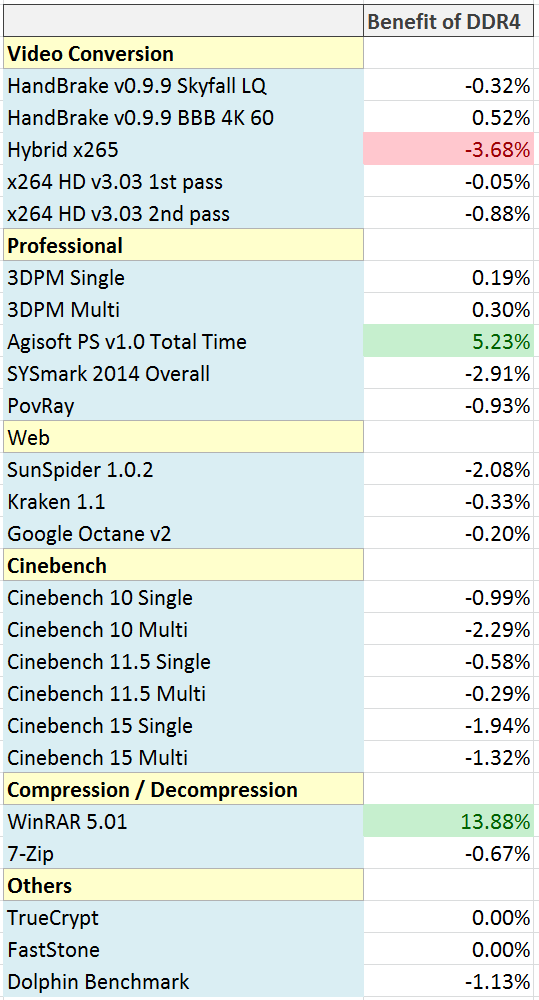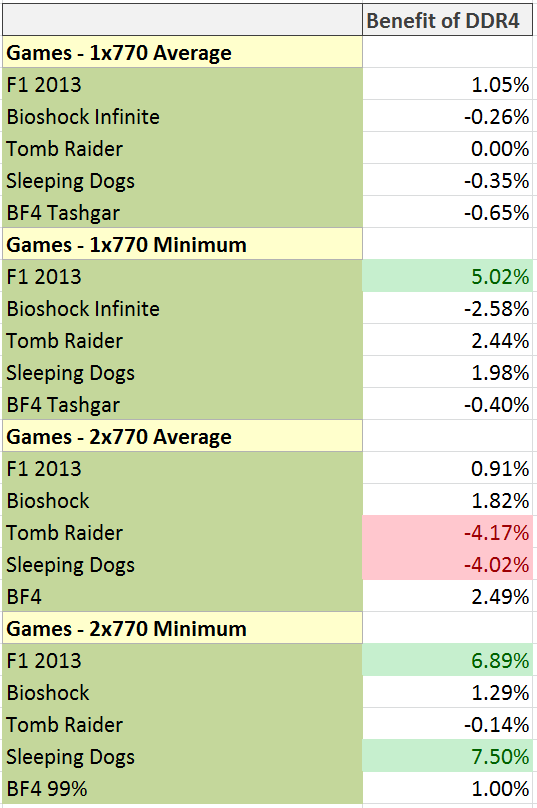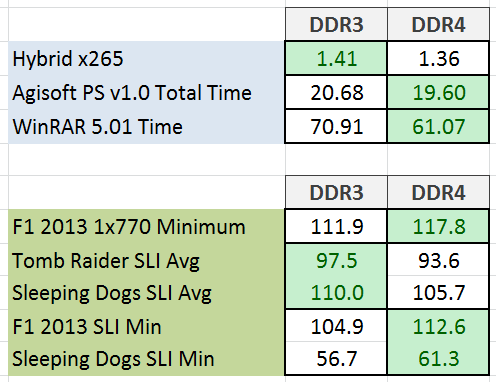DDR4 Haswell-E Scaling Review: 2133 to 3200 with G.Skill, Corsair, ADATA and Crucial
by Ian Cutress on February 5, 2015 10:10 AM ESTComparing DDR3 to DDR4
Moving from a standard DDR3-2133 C11 kit to DDR4-2133 C15, just by looking at the numbers, feels like a downgrade despite what the rest of the system is. Ideally we want the first number, the frequency, to be high and the second number, the latency, to be low. After spending several years dealing with DDR3, moving to DDR4 feels a bit of a backwards step when you look at solely the numbers on paper.
As part of this review we have covered many different areas where DDR4 is the upgrade of DDR3, not only in terms of voltage but some of the underlying concepts as well. This puts DDR4 in a position for upgradability in the future, especially when it comes to density and future technologies (see the next page for more information). But an ultimate question still remains: at the same frequency and latency, do they perform the same?
The only way to perform an identical comparison would be to have a platform that could probe both DDR3 and DDR4 while keeping the same CPU. If one comes along, we will test that, but in the mean time we can do some broad comparisons with near-identical systems.
For this test we took two Haswell based systems and compared them against each other. The first contains the Haswell-E i7-5960X processor, cut it down to run at four cores with no HyperThreading, fixed the CPU speed at 4 GHz and placed the memory into DDR4-2133 14-14-14 350 2T timings. We did the same with the second system, a Haswell based i7-4770K moved it to 4 GHz and making sure it was in 4C/4T mode. The OS was placed into a unique high performance profile and we ran our test suite. The only difference that remained between the two setups was the L2 and L3 cache, which we cannot change unfortunately.
In our non-gaming tests, there is one situation where DDR3 is more than 3% better and two where DDR4 is +3%. It is worth noting that most of the numbers, especially with things like the Web and Cinebench are actually slightly negative.
In the gaming tests, similarly there are more +3% on the side of DDR4. If we do a direct comparison regardless of the percentage, DDR4 wins 11 times compared to DDR3 getting 8, and almost of DDR3’s wins are minor except for two-way SLI. It would seem that for two-way SLI DDR4 at least brings up some of the minimum frame rates.
Pulling out the >3% difference numbers, just to see what the numbers exactly are:
On the face of it, the Hybrid result does not seem that different, whereas a full minute on Photoscan or 10 seconds in our WinRAR test feels like a difference. In the gaming tests moving nearer to 120 FPS or 60 FPS, especially in both of the minimum frame rate tests, is an important jump which happens with DDR4.
Overall, comparing DDR4 to DDR3, there is little difference to separate the two. In a couple of small instances one is better than the other, but on those edge cases it might be prudent to say that we cannot make a final decision until we can synchronize the rest of the system, such as the size of CPU caches. When we can perform such tests, we will run some more numbers.













120 Comments
View All Comments
ddriver - Thursday, February 5, 2015 - link
Upgrading became a non-issue around sandy bridge. My system is 3+ years old, and still within 10% of the corresponding tier of CPU today. Might as well be my last x86/Windows system before I switch to an ARM cluster under Linux...mdav9609 - Sunday, February 14, 2016 - link
Awesome! I've got an intel server board running two quad core Xeon E5620's (or something don't remember the exact numbers right now, socket 775) and their performance is almost as good as an i7 2600k, at least according to Passmark. I'm running them with an EVGA GTX 580. Got no problem running Fallout 4 and The Witcher 3 on it in 1080p. It's not my primary machine but I got one of these systems from work for free and put the second Xeon in it. Got it off eBay for like 15 bucks. Put in a few 15K SAS drives in RAID 0 and it is pretty cool. I like maxing out older systems just for the hell of it.pandemonium - Friday, February 6, 2015 - link
I thought it was pretty clear in this, and many, many, previous test comparisons of speed and DDR versions, that it makes very little difference. I'm on 8GB DDR2 and it's still going strong for everything I use it for. If it works...FlushedBubblyJock - Sunday, February 15, 2015 - link
Bingo - poor guy had to go through all that just so kingpins can win prizes flying around the world on enduser dimes.To the sane electorate, memory means number of GB.
I have to add I know plenty who, so long as the number is higher, they really and truly believe there is a performance increase. Sometimes they get confused, mixing generations of cpu's and memory, then their big brag on their junk doesn't work so well, but they still believe it.
So the memory marketing works, because there are an awful lot of people out there who fit the above description.
phoenix_rizzen - Thursday, February 5, 2015 - link
You're not alone.I have an HTPC running in the bedroom at home with an Athlon64 and 1.5 GB of DDR1. Plenty of horsepower for Windows XP, Google Chrome, and Plex web client, as it's connected to a 27" CRT TV.
One of my desktops at work is a tri-core Athlon-II system with 4 GB of DDR2 (AM2 motherboard)
My other work desktop is slightly more advanced, running a tri-core Athlon-II system with 8 GB of DDR3 (AM3 motherboard).
And the home server is just slightly more advanced still, running a quad-core Phenom-II system with 8 GB of DDR3.
nwrigley - Thursday, February 5, 2015 - link
I'm still running a quad Q6600 @ 3ghz with 8GB of DDR2. I've upgraded to an SSD and newer graphics card over its life. While money is certainly a limiting factor, in some ways there hasn't been a compelling reason to upgrade to a new machine.I work in video production and use high-end Macs at work. I often don't feel a difference between work and at home, with the exception of when the Mac doesn't have an SSD installed - then my system feels much faster (my boss isn't the type to upgrade an existing system, he'll just order a new one - very frustrating when a $200 SSD upgrade would make a huge difference).
I'm surprised just how well this processor has stood the test of time, but we haven't seen the type of performance jump that happened after the Pentium 4 era. The big performance jump we did see was with SSDs, so that's where I put my money (along with a bigger/better monitor.) My computer has also been a quiet and reliable workhorse - you never know what problems may come with a new system.
Murloc - Thursday, February 5, 2015 - link
I wouldn't feel compelled to change such a system either except for the sata/USB speeds, IF your use case can obtain advantages from faster speeds in that sector of course.nwrigley - Thursday, February 5, 2015 - link
Yep, you're absolutely right. A current motherboard would make both my SSD and GPU run faster with increased SATA and PCI Express speeds. USB 3.0 would be nice, but I don't have a current need for it.Guspaz - Thursday, February 5, 2015 - link
PCIe speeds in a Core 2 era system would still outstrip SATA on a modern system, though. Slap in an SSD using an x4 interface, for example, and you're talking 1GB/s of full duplex bandwidth even with PCIe 1.0, while modern SATA is still only doing around 600MB/s.Do you have any free PCIe slots that are more than 1x? Those could directly power a PCIe SSD, or you could stick in a SATA3 controller and use a SATA3 SSD. Ditto for USB3, if you did need it.
nwrigley - Thursday, February 5, 2015 - link
That's a good thought, unfortunately I only have PCIe 1x slots. Doesn't look like that would prGA-P35-DS3Rovide any benefit.